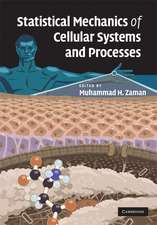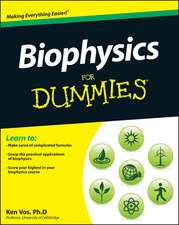Chemical Physics of Redox Metalloenzyme Catalysis
Traducere de Artavaz Beknazarov Autor Gertz I. Likhtenshteinen Limba Engleză Paperback – 15 dec 2011
Preț: 645.28 lei
Preț vechi: 759.15 lei
-15% Nou
Puncte Express: 968
Preț estimativ în valută:
123.51€ • 134.21$ • 103.82£
123.51€ • 134.21$ • 103.82£
Carte tipărită la comandă
Livrare economică 21 aprilie-05 mai
Preluare comenzi: 021 569.72.76
Specificații
ISBN-13: 9783642731020
ISBN-10: 3642731023
Pagini: 348
Ilustrații: XIV, 331 p. 81 illus.
Dimensiuni: 170 x 244 x 22 mm
Greutate: 0.55 kg
Ediția:Softcover reprint of the original 1st ed. 1988
Editura: Springer Berlin, Heidelberg
Colecția Springer
Locul publicării:Berlin, Heidelberg, Germany
ISBN-10: 3642731023
Pagini: 348
Ilustrații: XIV, 331 p. 81 illus.
Dimensiuni: 170 x 244 x 22 mm
Greutate: 0.55 kg
Ediția:Softcover reprint of the original 1st ed. 1988
Editura: Springer Berlin, Heidelberg
Colecția Springer
Locul publicării:Berlin, Heidelberg, Germany
Public țintă
ResearchDescriere
"Chemical physics is a science of the physical foundations of chemical transformations" (N. N. Semenov). The main objective of chemical physics is to disclose the detailed mechanism of chemical reactions and to learn to control these processes. The physico-chemical approach hinges upon the extensive application of methods of molecular physics and chemical kinetics. Based originally on simple gas-phase processes, chemical physics gradually extended its sphere of interest to liquid-phase reactions and to processes taking place in solids, including polymers. At present, we witness the fact that the ideas and methods of this science penetrate deeper and deeper into modern molecular biology, including enzyme catalysis. This monograph treats, from the standpoint of modern chemical physics, the principal general and individual features of the structure and mechanism of action of various classes of oxidation-reduction (redox) metalloenzymes. There are several reasons for which this branch of science attracts the attention of specialists in various fields - from biologists and those working in medicine to chemists and theoretical physicists. First of all, is the enormous biological and biochemical importance of processes catalyzed by metalloenzymes. These include biological ox idation with oxygen, oxidative and photo-phosphorylation, atmospheric nitrogen fixation, assimilation of nitrates and sulphites, phototransport of electrons, hydrogen evolution and hydrogenation and photo-oxida tion of water, which is far from a complete list of such processes.
Cuprins
1 General Information on Metalloenzymes and Metal Carriers.- 1.1 The Discovery of Metalloenzymes.- 1.2 The Main Biological Role of Metalloenzymes.- 1.3 Classification and Nomenclature of Metalloenzymes and Metal Carriers. Mechanisms of Enzyme Action.- 2 Physical Methods of Investigation of Metalloenzymes.- 2.1 Physical Methods. General Principles.- 2.2 Mössbauer Spectroscopy.- 2.3 X-Ray Absorption. X-Ray Photoelectron and Photoelectron Spectroscopy.- 2.4 Extended X-Ray Absorption Fine Structure (EXAFS).- 2.5 Ultraviolet and Visible Spectroscopy.- 2.5.1 Absorption Spectra.- 2.5.2 Optical Rotation and Circular Dichroism. Magnetic Optical Rotation and Magnetic Circular Dichroism.- 2.6 Infrared and Raman Spectroscopy. Resonance Raman Scattering.- 2.7 Electron Paramagnetic Resonance.- 2.7.1 General.- 2.7.2 Specificity of EPR Spectroscopy of Transition-Metal Complexes.- 2.7.3 Effect of Spin-Spin Interactions of the Parameters of EPR Spectra.- 2.8 Electron-Nuclear and Electron-Electron Double Resonance. Magnetic Nuclear Modulation.- 2.9 Nuclear Magnetic Resonance.- 3 Physical Label Techniques.- 3.1 The Spin-Labelling Technique.- 3.1.1 General.- 3.1.2 Effect of Rotational Diffusion on the EPR Spectra of Nitroxide Radicals.- 3.1.3 The Double-Label Technique.- 3.1.4 The Spin Label-Spin Probe Method.- 3.2 Luminescent Labels.- 3.2.1 Physical Principles.- 3.2.2 Inductive-Resonance Energy Transfer.- 3.2.3 Triplet-Triplet Energy Transfer. Triplet Labels.- 3.3 Electron-Scattering Labels.- 3.3.1 General.- 3.3.2 Electron Microscopy.- 3.3.3 Small-Angle X-Ray Scattering.- 3.4 Mössbauer Labels.- 4 Kinetic Methods in Enzyme Catalysis.- 4.1 Kinetics of Cooperative Processes.- 4.2 Experimental Methods of Studying the Kinetics of Enzymatic Reactions.- 4.3 Methods of Studying the Mechanism of Enzymatic Reactions.- 4.4 A Semi-Empirical Method of Calculating the Enthalpy of Chemical Reactions.- 5 Factors Affecting the Efficiency of Catalysis.- 5.1 General Conceptions of Chemical Kinetics.- 5.2 Thermodynamic Feasibility of the Chemical Step.- 5.3 Collision of Reactants. Steric and Electrostatic Factors.- 5.4 Orientational Effects.- 5.5 Elementary Acts of Chemical Reactions.- 5.5.1 General Principles.- 5.5.2 Adiabatic Reactions. Activation Energy and Entropy.- 5.5.3 Inner-Sphere Non-Adiabatic Reactions. Quantum- Mechanical Selection Rules.- 5.5.4 Outer-Sphere Non-Adiabatic Reactions. Long-Range Tunnelling Processes.- 5.5.5 Synchronization of Nuclei in an Electronic Concerted Reaction.- 5.6 Activation of the Substrate in the Coordination Sphere of a Transition Metal. Specific Feature of the Structure of Clusters.- 5.7 The Principle of “Optimal Motion” in Elementary Acts of Chemical and Enzymatic Processes.- 6 Iron-Containing Proteins.- 6.1 Heme Proteins.- 6.1.1 Myoglobins and Hemoglobins.- 6.1.2 Cytochromes.- 6.1.3 Peroxidases.- 6.1.4 Catalase.- 6.1.5 Cytochrome P-450.- 6.2 Non-Heme Proteins.- 6.2.1 Ferredoxins.- 6.2.2 Iron-Sulphur Enzymes.- 6.2.3 Transport and Storage of Non-Heme Model Proteins.- 7 Iron- and Molybdenum-Containing Oxidoreductases.- 7.1 Xanthine Oxidase.- 7.1.1 General.- 7.1.2 Kinetics and Mechanism of the Xanthine Oxidase Reaction.- 7.2 Other Molybdenum-Containing Oxidoreductases.- 7.3 Nitrogenase.- 7.3.1 General.- 7.3.2 Kinetics and Mechanism of Nitrogenase Reactions.- 7.3.3 The Structure of Metal-Containing Active Sites.- 7.3.4 The ATPase Site.- 8 Copper-Containing Enzymes.- 8.1 Blue Copper-Containing Enzymes.- 8.1.1 Ceruloplasmin.- 8.1.2 Laccase and Ascorbate Oxidase.- 8.2 Copper-Containing Monooxygenases and Oxidases.- 8.3 Electron and Dioxygen Carriers.- 9 Electron-Transport and Energy-Transformation Systems.- 9.1 The Mitochondrial Respiratory Chain.- 9.2 Electron-Transfer and Water-Oxidation Systems in Photosynthesis.- 9.2.1 The Primary Photoelectron-Transport During Bacterial and Plant Photosynthesis.- 9.2.2 The Role of Manganese in the Photo-Oxidation of Water to O2.- 9.3 The Microsomal Oxidation System.- 9.4 The Methane-Hydroxylating System.- 10 Energy, Entropy and Molecular-Dynamic Relationships in Enzyme Catalysis.- 10.1 Relationships Between the Energy and Entropy Parameters of Enzymatic Processes.- 10.1.1 Experimental Data.- 10.1.2 Theoretical Treatment.- 10.2 Molecular-Dynamic Properties of Proteins and Enzymes.- 10.2.1 General.- 10.2.2 Methods of Studying the Intramolecular Dynamics of Proteins.- 10.2.3 Experimental Data on the Intramolecular Dynamics of Proteins.- 10.2.4 Theoretical Conception of the Intramolecular Dynamics of Proteins.- 10.2.5 Intramolecular Dynamics and Functional Properties of Proteins.- 11 Mechanisms of the Elementary Acts of Redox and Coupled Processes Involving Metalloenzymes and Carriers.- 11.1 One-Electron Transfer.- 11.1.1 Theoretical Concepts. General.- 11.1.2 Electron Transfer and Spin Exchange.- 11.1.3 Methods of Quantitative Estimation of the Electron-Transfer Parameters in Proteins.- 11.1.4 Experimental Data on One-Electron Transfer in Metalloenzymes.- 11.1.5 Electron Transfer in Photoseparation of Charges in Photosynthesis.- 11.2 Multi-Electron Mechanisms of Redox Reactions.- 11.2.1 General Principles.- 11.2.2 Two-Electron Reduction of Dioxygen.- 11.2.3 Oxidation and Hydroxylation Reactions Involving Heme Enzymes.- 11.2.4 The Four-Electron Mechanisms of Dinitrogen Reduction and Water Oxidation.- 11.3 The Chemical Mechanism of the ATPase Reaction in Energy-Conversion Systems.- 11.4 Conclusions.- References.












